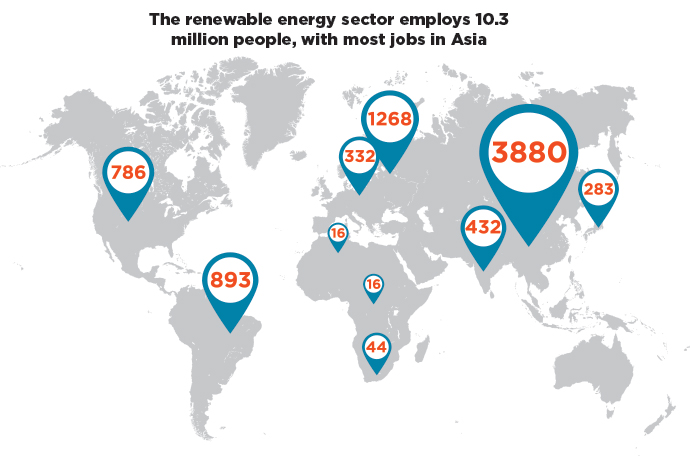Renewable power is gaining a foothold as a meaningful factor in corporate footprints.
An updated report from international law firm Bird & Bird delivers business intelligence about corporate renewable power purchase agreements (PPAs), as 121 corporations around the world purchased 13.4 GW of clean power directly from generators in 2018, more than doubling the record set in 2017.
The trend has ramifications for company location decision-making, especially as new government policies and new corporate initiatives converge. Nowhere is that convergence more evident than in Europe, where the Nordics lead the way, but Spain, Poland, Italy and Germany are picking up the pace.
There were 5.7 GW of corporate PPAs signed between January and July 2019 with an even split between wind and solar. The largest markets continue to be the U.S. and the Nordics, accounting for over 80% of corporate PPAs.
Tech and data center companies dominate the corporate PPA landscape, led by Amazon, Microsoft, Apple and Google. “For example, in April 2019 Amazon announced three new corporate PPAs for a combined total of 229 MW from new wind projects in Ireland, Sweden and California,” Bird & Bird reports. “However, chemical companies have also been active in 2018 through the likes of aluminum manufacturers Norsk Hydro (235 MW onshore wind project in Sweden) and Alcoa (330 MW and 197.4 MW onshore wind projects, both in Norway), both of whom are using sustainability credentials to sell aluminum at a premium in some markets. Telecom companies are now also participating in the market, and in November 2018 Exxon Mobil announced its first two corporate PPAs (250 MW onshore wind project and 250 MW solar PV, both in Texas).”

More are on the way, Bird & Bird reports. A blend of corporate renewable energy pledges and “economic drivers such as the continued fall in the levelized cost of electricity/energy (LCOE) with regard to renewables and the phasing out of feed-in-tariff-based fiscal incentives in several jurisdictions should continue to push the growth of corporate PPAs globally in the second half of 2019 and beyond.”
Coastal Surge
A sudden gust of news this fall has swept offshore wind power to the forefront. GE is leading the charge, including offshore agreements for the 120 MW Skipjack and 1,100 MW Ocean Wind projects off the shores of Maryland and New Jersey, respectively, and the 3,600 MW Dogger Bank offshore windfarm in the UK.
Serial production of GE’s huge Haliade-X 12 MW wind turbine blade will start at the second half of 2021 at its plant in France. GE is also testing the Haliade-X at a wind technology testing center in Charlestown, Massachusetts, not far from where the Commonwealth recently opened a new training center for the industry. Mayflower Wind, a joint venture owned by Shell and EDP Renewables, was selected to provide about 800 MW from a wind farm to be built in south of Martha’s Vineyard and Nantucket. It would power around 470,000 homes.
The Skipjack and Ocean Wind projects will be operated by Ørsted U.S. Offshore Wind, which operates the Block Island Wind Farm, America’s first offshore wind farm off Rhode Island, and has been awarded over 2,900 MW of capacity through six projects. The company does not lack for ambition: “In the U.S., we have the potential to deliver clean energy to the seven states on the East Coast that have committed to build more than 10 GW of offshore wind capacity by 2030,” Ørsted says.
Among the projects is Constitution Wind off the coast of Connecticut. In November, Ørsted and co-developer Eversource pledged more than $100 million to Connecticut communities and organizations, and have also committed to invest $57.5 million in $93 million worth of upgrades to New London State Pier to create an offshore wind staging hub.
Another Northeast project is Revolution Wind off the coast of Rhode Island. Separately, GEV, one of the largest wind turbine maintenance companies in the world, announced it will make Rhode Island the home of its U.S headquarters, creating approximately 125 jobs.
Another wind hub is scheduled to spin into action in Maryland, where Ørsted in July announced an agreement to develop Maryland’s first offshore wind energy staging center at Tradepoint Atlantic, the 3,300-acre global logistics center in Baltimore County, in order to first serve the needs of the Skipjack project. The center at the former Sparrows Point steelmaking site advances Ørsted’s commitment to create 1,400 jobs in Maryland.
“We are proud to work with Tradepoint Atlantic to make clean energy the newest chapter in the storied history of the Sparrows Point site as we pursue our vision of a world that runs entirely on green energy,” said Claus Møller, COO of Ørsted U.S. Offshore Wind.

